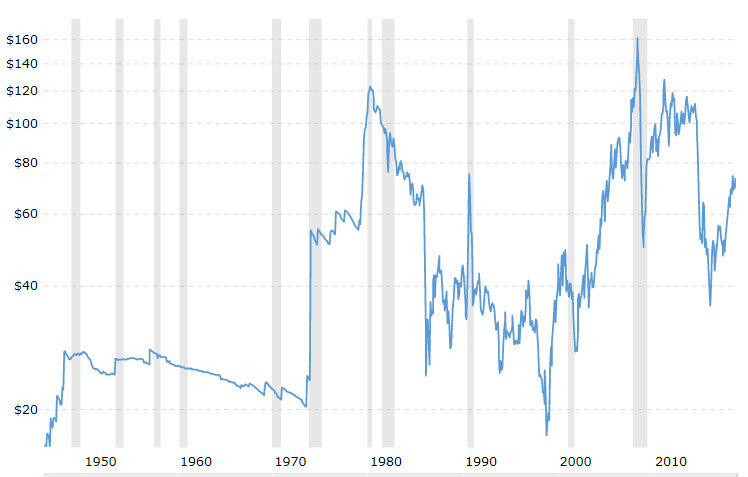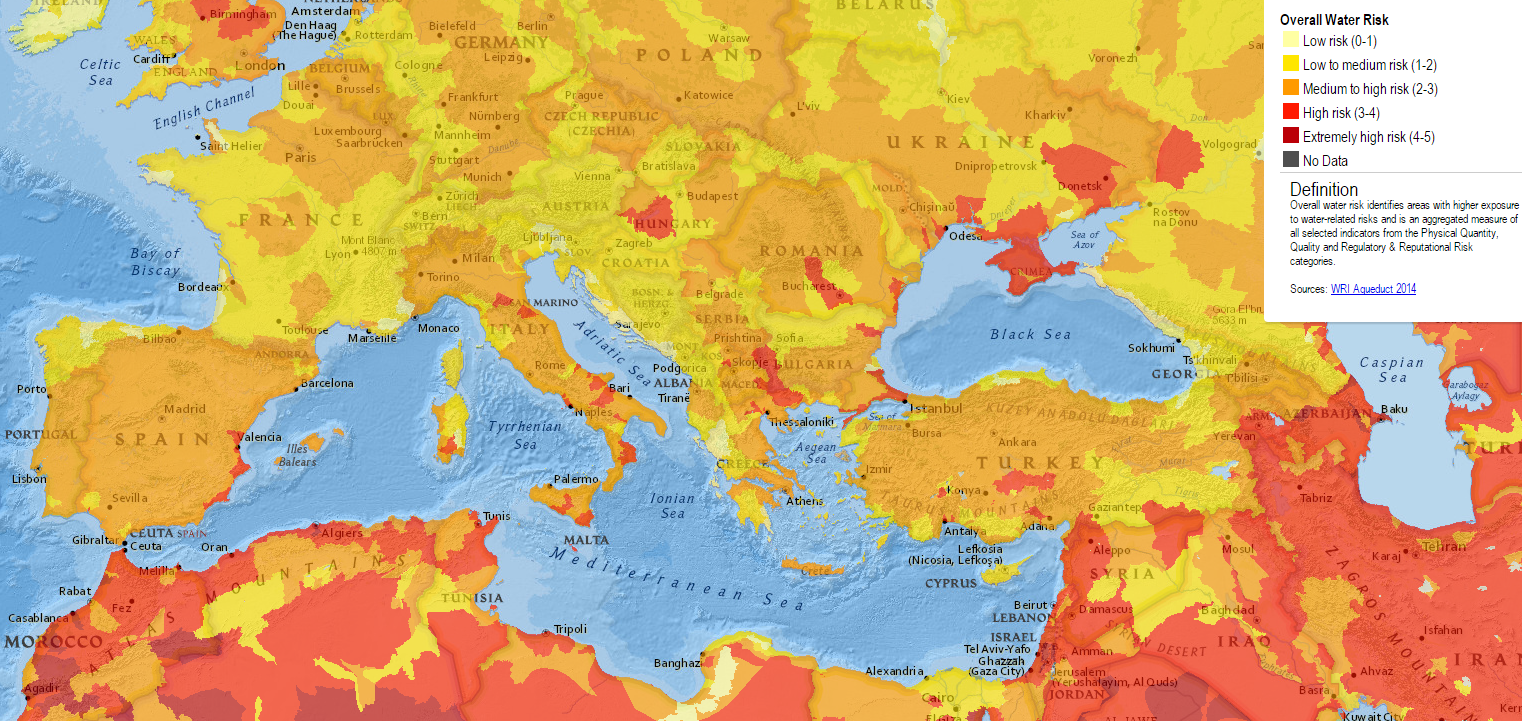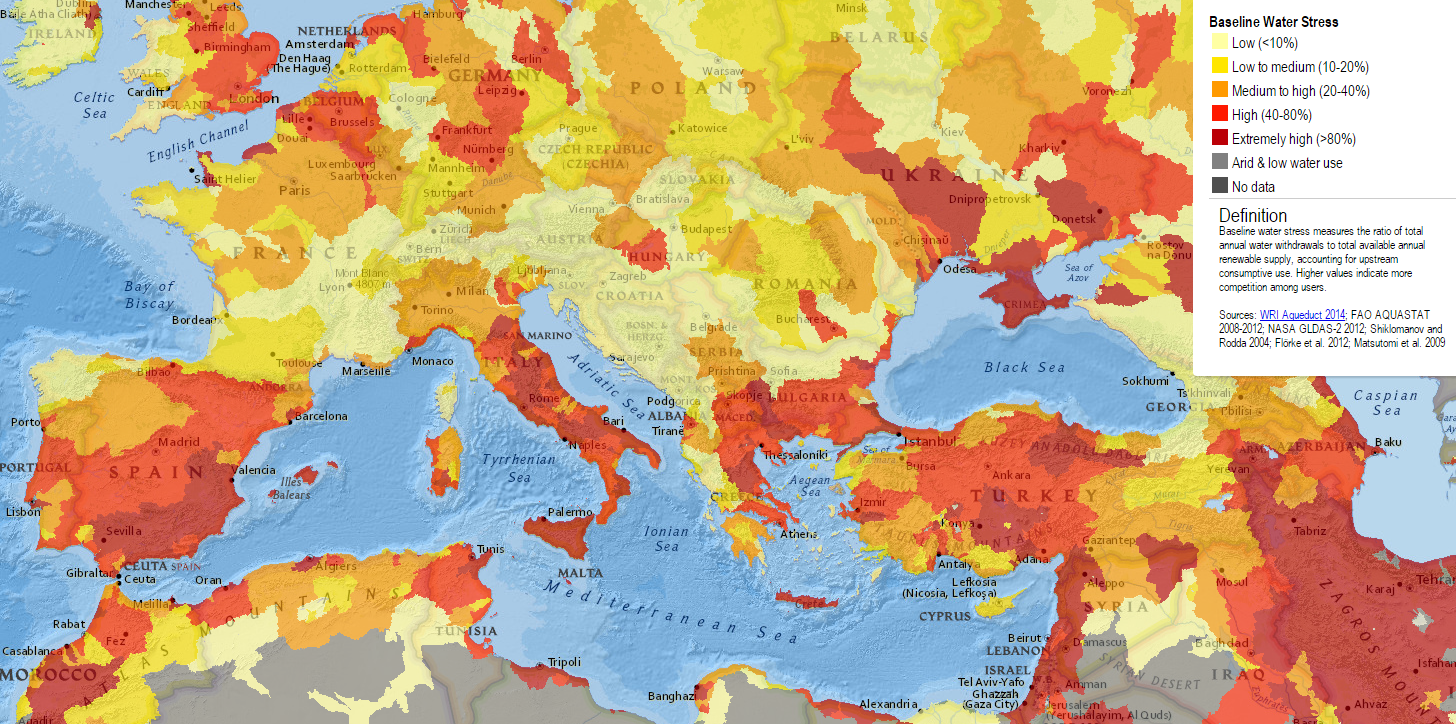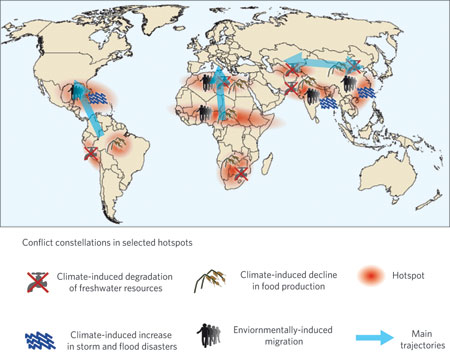 |
| Source: FAO Aquastat, Oxford Analytica |
When people from the West and its mainstream media try to analyse what's happening in the Middle East all they talk about is armed conflict and war. But never do they mention the deep fundamental drivers of energy, water scarcity and climate change.
Many countries in the Middle East are extremely vulnerable and on the verge of break down because they cannot deal with mounting economic/energy and environmental costs. Only a little disturbance is needed to make these states fall apart and then all hell can break loose. It has nothing to do with what type of people they are, its simply a matter of survival that brings out the worst in people. When water resources dry up, agriculture collapse, there's no way to make and income and food becomes unaffordable people tend to riot no matter which country. Thats what happened during the French revolution, after 1 million died from famine and peasants turned on the ruling elite.
Displaying a complete lack of understanding of the situation, and utter lack of morality, the imperial powers decided to try and grab the regions oil resources by getting rid of Saddam Hussein but instead created a power vacuum that was filled by al-Qaeda extremists who rapidly transformed into the Islamic State. Then followed by a proxy war over resources and power between many different actors in the region. Never ending fighting with no real benefits for anyone involved. The US "divide and rule" strategy is an utter failure.
Intensifying the fight against extremists doesn't deal with the fundamental drivers of why they exist in the first place. Instead its producing more extremists as the conditions that laid the groundwork for the rise of IS are worsening. The long-term ecological crisis of especially water stress is worsening in the region. Severe drought conditions intensified by water mismanagement and climate change have led to failed crops and lack of clean drinking water. Leading to increasing food import reliance and pushing people to move into the cities where there are no job opportunities, creating tensions. Then government subsidies for food and fuel get slashed as state revenues from falling oil exports decline. This at a time when oil and food prices have steadily risen and have had major spikes on the international market. That's the perfect storm.
Absolutely nothing have been done to build local capacity to cope with extreme weather or manage ecosystems more sustainably. The conditions of deepening water scarcity are projected to intensify in coming years and decades. Meanwhile population keeps growing. And that's why the future in the region looks bleak. The US idea of turning Iraq into a booming oil economy is simply nonsense. Even if there is still more oil left in Iraq, compared to Syria, Yemen or Egypt, they too will face peak oil within a decade or so. Hedging your entire future on oil is utterly idiotic and as we witness very destructive.
Yemen reached a production peak in oil in 2001 and has now practically collapsed. Acute water scarcity and lack of food is reaching levels of mass famine. Nationwide fuel shortages are routine and economic activities have come to a halt. Livelihoods are destroyed, people starve and live in misery, and yet the US and UK support Saudi Arabia's bombing campaign of the country.
 |
| The Conflict Shoreline by Eyal Weizman. Shows the aridity line, areas of about 200 millimetres of rainfall a year, considered the minimum for growing cereal crops on a large scale without irrigation, and western drone strikes in red dots |
Egypt has become a net importer of oil and food and is struggling to pay its bills for a growing population. Poor water management (irrigation, pollution, dumping of waste) and growing demand has led to water scarcity in the country. Cairo residents don't have access to water for large portions of the day. The
U.N. World Water Development report for 2018 warns that Egypt is currently below the U.N.’s threshold of water poverty and dramatically heading towards absolute water scarcity (500 m3 per capita).
Even if we are able to limit global warming to 2 degrees the Middle East and North Africa (MENA) region will become unbearably hot and many parts unlivable in the coming future. Prolonged heat waves and dust storms will plague the already arid region. Destroying much of the region's agricultural potential.
Researcher are expecting a
climate exodus from the region. Of which we have seen only the beginning.
Climate mayhem, falling net energy and debt deflation
We are in for another
global oil supply crunch from 2018 onwards that many experts say will trigger another severe economic recession if not depression. A fragile global economy, with a massive debt overhang,
cannot handle too high oil prices. A large portion of most countries budgets, and individuals budgets as well, are spent on fossil fuel energy. That's why rapid price increases (over $60 per barrel) crushes demand and flips the economy over into a recession. In turn, leading to the bankruptcy of non-profitable unconventional energy ventures like tar sands and fracking. Thus further reducing supply over the long term.

Since the early 1970s global energy costs have steadily increased. Even if oil prices have oscillated with recurring spikes and drops, as the economy tries to adjust, the overall trend is a steady increase. This is due to the fact that extraction has become increasingly difficult and costly, yielding ever lower return on investment. The problem of course is that we built our economies based on cheap energy that yielded relatively high net energy to society. But that is a thing of the past and now we are struggling to afford our current lifestyles. Thats basically why we started this
massive global debt bubble, pulling forward future consumption with cheap credit. But costs will eventually have to be paid.
We have now reached a point when all the energy and resources available to society are required just to maintain our
existing level of complexity. A phenomenon puzzling many commentators, calling it
secular stagnation. All these factors have made the global economy so fragile that even small perturbations from climate change, wars or falling credit could tip the system over into a deflationary spiral. With economic inequalities already increasing, increasing
social instability, this is a recipe for disaster.
No economy will be able to recover unless it transitions to non-fossil fuel energy sources and writes down its debts. And even then net energy will likely be much lower, meaning that society still has to lower its overall consumption of energy and resources. Implying a voluntary measure to reduce organizational complexity in society. Something few previous civilisations managed, perhaps the British did when they dismantled their empire.
Implication for food security
Global food prices have increased steadily since 2005, about the time of global peak oil, now at 1970s highs or above. Further exacerbating the problem is booming populations, freshwater scarcity and climate change.
Today’s population levels depend on fossil fuels and industrial agriculture. Especially vulnerable to rising food prices are people with low purchasing power and without subsistence farming to fall back on. We know that food price increases that reach 200 on the FAO index have led
to riots and unrest.
Many countries in the Middle East are especially vulnerable due to convergence of several different crises. State revenue losses from falling oil exports, due to depleting resources and higher domestic consumption, with a need to cut food and fuel subsidies usually make people very upset. Especially when, as is the case in the region, people have no way of making a living coupled with overexploited water reservoirs and eroded soils. As if that wasn't enough, scorching heat and significant risk of recurrent droughts makes the entire region utterly unsustainable. Without energy they have nothing. The chances for further conflict and wars in the region are high. Massive, continuing, migration flows towards Europe is to be expected.
A dry spring in the southeast
Measuring stations in Böda on Öland, Gotska Sandön and in Ronneby show record low groundwater levels that normally would only occur during August-September. According to
Geological Survey of Sweden, groundwater levels in this region have been dropping continuously for the last five years. However, cyclical variations of high and low groundwater levels of 11-12 years are not uncommon.
Without large amounts of rainfall in April, before the growing season starts, groundwater levels will not be able to return to normal and communities may experience problems of water availability. Shallow wells are most affected by low groundwater levels as they risk drying out. In low lying coastal areas there is also a risk of saltwater intrusion. Out of 9 million 1.2 million people in Sweden rely on groundwater from private wells.
Restrictions on irrigation on Gotland came into force already on 1st of April since the region want to avoid heavy restrictions during the summer when tourism is booming. Gotland municipality has also decided to build a desalination plant that should be operational this summer according to
NyTeknik. Desalination is however a very energy intensive and expensive process but perhaps the brackish Baltic water is less costly to desalinate.
It is likely that southeast Sweden will increasingly face problems of groundwater scarcity while the rest of the country will experience higher groundwater levels as a consequence of climate change.
Spring has so far been unusually warm which means an earlier growing season and migration of birds. March was warmer than average in the entire country, with 3-4C above average in parts of middle and northern Sweden.
 |
Dust storm sweeping across Syria, the Mafraq region of Jordan, and part of Turkey's Mediterranean coast (7th of September, 2015). Credit: NASA Earth Observatory- Aqua Modis
|
Global pressures on finite water resources have grown rapidly over the past decades as a result of population growth, increasing per capita consumption and industrial agriculture. Overexploitation of groundwater in agricultural regions of particular concern are
north-western India, the
north China plain, the
Great Plains of North America and the
Central Valley in California (
Rockström et al. 2014). Climate change is already impacting the number of people living in absolute water scarcity (
Schewe et al. 2013).
Water scarcity is a recurrent imbalance that arises from an overuse of water resources, caused by consumption being significantly higher than the natural renewable availability. Water scarcity can be aggravated by water pollution and drought.
River basins, with withdrawals exceeding more than 40–60% of available water resources, experience severe water scarcity. Many economically important river basins around the world are suffering from unsustainable withdrawals of water that impinge on ecological needs or have surpassed ecological limits such as the Amu and Syr Darya, the Indus, the Nile, the Colorado, the Orange, the Lerma Chapala, the Murray Darling and the Yellow River basin.
Global hydroregions - population pressures on water security
The map above shows a
relative pressure indicator (incorporating population density and runoff) for river basins in different hydroregions of the world. We can see that dry belts (medium density and very low runoff) around the equator and northern mid-latitude (high density and medium runoff) have the highest pressure on water security, while hydroregions with minimal pressure are due to high runoff and/or low population density (e.g. Amazon and Orinoco basin, Boreal hydroregions, Northern Australia basins) (
Meybeck et al. 2013). Water security pressure range from the most to the least densely populated:
Asia > Europe > North America > Africa > South America > Australia. Interesting to note is the difference between the “Old World” (Asia, MENA, Europe) and the “New World” (Americas and Australia).
Overall Water Risk around the Mediterranean
 |
Shows level of overall water risk (physical quantity, quality and access).
Source: Aqueduct-Water Risk Atlas |
In the map above we see which countries and city regions around the Mediterranean that suffer most acutely from overall water risk. London, Budapest, Bucharest, Valencia, Naples, Odessa, Donetsk, Sofia, Istanbul all show signs of high overall water risk due to population pressure. Countries in the dry belt of North Africa and the Middle East (MENA) all show signs of high overall water risk, either from depletion of water resources, pollution or lack of access to clean drinking water.
Baseline Water Stress around the Mediterranean
 |
| Shows baseline water stress (the ratio of total annual withdrawals to total available renewable supply). Source: Aqueduct-Water Risk Atlas |
If we look at baseline water stress defined as the ratio of total annual water withdrawals to total available renewable supply (accounting for upstream consumptive use) we find that stress is extremely high (dark red) in parts of Morocco, Tunisia, Spain, Italy, Malta, Bulgaria, Greece, Turkey, Ukraine, Israel, Syria, Iraq, Egypt, Azerbaijan, and Iran. If we compare the map above to the one below, showing population pressure in the Mediterranean region (in 2009), we find that baseline water stress occurs around many of the big cities as expected.
Population density around the Mediterranean
City regions along the Mediterranean east coast in Turkey, Syria, Lebanon, Israel and Egypt have high population density in close proximity to each other. This at the same time as they suffer from extremely high baseline water stress is like begging for a conflict. Italy, Spain, Greece and Malta will suffer in the future if they don't do something about their unsustainable water situation immediately. Morocco, north Algeria and Tunisia will also have to address their water situation.
Access to Water in Europe and MENA
 |
| Shows level of water risk related to access (% of population without access to safe drinking water). Source: Aqueduct-Water Risk Atlas |
People may not perceive water stress as an issue depending on access to water defined as % of population without access to improved drinking water. Here we see the situation being severe (>20%) in countries undergoing conflict such as Iraq, Syria, Yemen, Afghanistan and large parts of North Africa. In the map below we can see that Spain, Morocco, Algeria, Tunisia, Libya, Egypt, Saudi Arabia, Israel and Cyprus all have desalination plants (red ring). This requires lots of energy, most likely from fossil fuels, that many countries can’t afford to spend and it only furthers global warming. Relying on desalinated water is a very risky strategy.
Water infrastructure around the Mediterranean Basin
From all the above pictures it is not difficult to figure out that
water stress, together with climate change and peaking fossil fuels will lead to migration and conflict without any foresight or planning ahead. Water is essential for all life, without sufficient water resources people have no option but to move as ecosystems dry out. Relying on groundwater pumping and fossil aquifers with little respect for ecological limits or plans for collecting rainwater is a disaster in the making, of which we are seeing the first signs. Furthermore, explosive population growth in the MENA-region following their oil boom have lead to far more people than the arid landscape can provide for. The only reason this population increase was even possible was due to fossil aquifers now empty and massive amounts of energy from oil that has been used to desalinate water from the ocean. But these are
finite resources. Thus the crisis we now see in the Middle East was foreseeable, it was only ever a question of
when, not if. The German Advisory Council on Global Change
reported on these risk already in 2007. Most other European countries must also have been aware of these risks. A little planning could have gone a long way but all we see now instead is
chaos.
Migration pattern due to ecological degradation and climate change
 |
| Areas where drought, desertification, and other forms of water scarcity are estimated are expected to worsen and could contribute to people migrating away from these areas to secure their livelihoods. Main projected trajectories are added where climate change-related migration can be expected in the future. (Source: Bogardi and Warner, 2009). |
 |
| The Amazon River in Brazil. Source: NASA |
The Bloodstream of the Biosphere
Human pressure on the Earth’s Biosphere is so large that geologists have announced that we live in a new era, the Anthropocene, in which humanity is the largest driving force of global change. The mounting stresses on the biosphere to support 7,3 billion (to become 9 billion) people may cause collapses and major shifts in ecosystems, from local to global scales. The ability to generate social and economic well-being is now threatened. Freshwater is at the centre of this change.
Freshwater
Freshwater is the bloodstream of the terrestrial Biosphere. Greenwater (used by plants) and blue water (rivers and groundwater) are linked across all scales. It is a resource that supports human health, industry and energy generation. Many water systems have undergone ‘regime shifts’ whereby disturbances forces the water ecosystem to flip to an alternative stable state. For example, the Baltic Sea has gone from a low nutrient clear state to a high nutrient murky state due to eutrophication and overfishing. Potential future regime shift, with global implications, include the dieback of the Amazonian rainforest, Arctic ice loss and the Atlantic deep-water formation.
Water for food
Food production is the world’s largest user of freshwater. In many countries such as Brazil and China diets are changing to include more meat and dairy product which increases food water requirements. Globally, as much as 40% of the grain produced is converted to animal feed. By 2050, currently available water for croplands will not be sufficient for producing enough food for humanity. Agricultural water management is key to lowering freshwater depletion rates and increasing farm productivity. Global consumptive use of blue water has been estimated at 2600 km3 per year. Several regions already suffer from the widespread impacts of the overuse of blue water. River basins with withdrawals exceeding more than 40-60% of available water resources experience severe water scarcity. The number of people living in areas which suffer from blue water scarcity is soaring. In 2005, about 35% of the global population where living in areas with chronic water shortage.
Unsustainable water use
About half of the river water withdrawn for societal use has evaporated, literally consumed during use, and about 25% of the rivers on land are highly affected by overuse of blue water. River depletion is considerable in irrigated regions of the world and many economically important river basins are already surpassing their ecological limits. Blue water security is subject to a high level of vulnerability to change in both Asia and Africa. For example, the Indus and Ganges-Brahmaputra-Meghna basins upon which some 1.5 billion people depend are highly vulnerable to change. Zones of particular concern are north-western India, the north China plain, the Great Plains of the US and the Central Valley in California. At the national scale, 5 countries are withdrawing more groundwater than can be recharged in aquifers, these include: Saudi Arabia, Libya, Egypt, Pakistan and Iran.
Climate Change and rainwater
Until recently, humans have been able to assume that precipitation was relatively stable and predictable. However, new insights now show that this assumption no longer holds. Climate change is a major driving force of a changing water landscape and its projected that a 2 °C increase in average global temperatures will result in an increase of 40% of people living in absolute water scarcity. Floods and droughts will become more prominent and rainfall patterns could change. There are large uncertainties about future rain, monsoon and snow patterns that influence river flows. Glacial melt has been widely observed in the mountain water towers of the world, including the Himalayas, the Andes, the Alps and the Kilimanjaro.
Worst drought in a century
Last couple of years (2012-2014) California has experienced severe drought conditions. However, the worst effects won’t be felt until this year when the conditions continue due to lack of precipitation and record heat. This winter has been the
warmest on record in California, resulting in less snow and rain. The overall trend toward drought persistence has continued, depleting already low snowpacks and reducing spring runoff for much of the region. The lack of snow raises concerns for this years spring and summer water supplies.
California's record warm winter comes after the warmest year on record globally, 2014. The 2012-2014 Californian drought has already been claimed to be the
worst drought in 1200 years, according to a new
study.
Last week governor Jerry Brown declared
restrictions for water use for the first time in California history. Over 400 local water plants are now forced to reduce water consumption by 25% compared to 2013 levels. Other restrictions include: a ban on garden irrigation other than drip irrigation, limits on golf course and churchyard irrigation, detailed water use reporting by farmers etc.
Previously, groundwater was only used as reserves but now they are pumping like crazy. Some regions have reported collapsing soil and salt intrusion, both a sign of
overpumping. Despite the very serious water scarcity, California is
the only state in Western US that have no limits on private pumping or consumption of groundwater.
Farmers can buy water rights from one another and they can pump as much groundwater as they like. As a result, the state's groundwater has been depleted considerably. Gov. Brown recently signed a restricting groundwater use law but it will take years to implement and it doesn't require groundwater basins being run sustainably until 2040. Too little too late, in my opinion.
Colorado river groundwater is also disappearing at a stunning rate. Streamflow from the river is the
most overallocated in the world. Demand for this renewable resource is now outstripping supply, according to a
2014 study. Between December 2004 and November 2013, more than 75% of the water lost in the Colorado River Basin was from groundwater. The region has been experiencing drought conditions for the last ten years according
NOAA.
Because of the long duration of these drought conditions, all kinds of people are becoming interested in expert opinion on climate-related topics. Unfortunately so far it seams like most are
only interested in whom to blame. Hopefully Californians and the rest of Americans will start realising that climate change is already happening, and effecting them personally. Maybe then negotiations on climate change will take a turn for the better, but it has to happen before December 2015.

.png)















